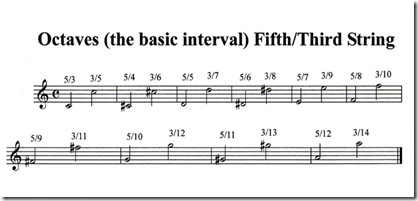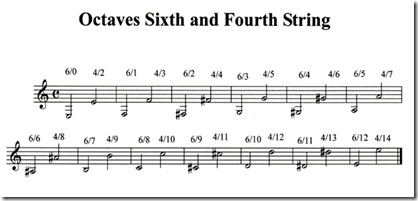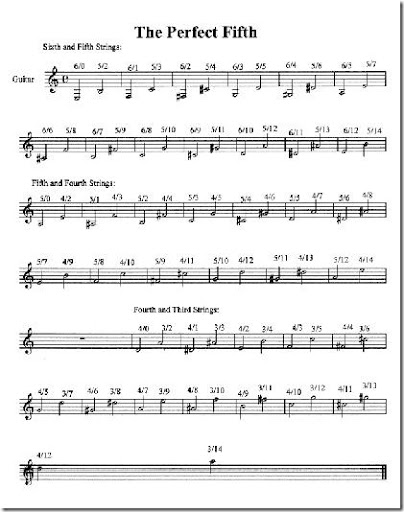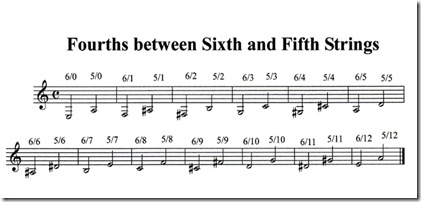PART THREE should have demonstrated to you that the fingerboard holds no real surprises. There is a logic to the layout that makes life easier -- despite what you thinks when first faced with all those dots, fret wires and strings.
Knowing the intervallic relationships between the strings leads us to explore what intervals are easily derived from this basic knowledge. Last session I ended with the idea that the entire fourths relationship thing gets screwed up when we go from the third to the second string. I had stated that the second and first strings are back into fourths relationship and showed a diagram comparing the second and first string. Here's the diagram for the fourth and third string. (We'll look at intervallic relationships between the third and second strings a bit later.)
Okay, this shows the fourths intervallic relationship between the two strings when you play them either both open, both at the first fret, both at the second... and that would make reading easy if that were all we ever did. Now I know that a unison is the most basic interval, but a unison kind of borders on the theoretical unless you're working with a choral group. I like to consider the octave to be the simplest and most basic interval. So...
Due to size constraints, I have stared the comparison at the third fret. Please note that if you play the note on the fifth string with your first finger and the note on the third string with the third finger, it just slides right up the neck forming a finger/fretboard pattern. You want to get the feel of this interval under your finger. By doing so, you will almost instinctively know that if you're playing a D# on the fifth string, sixth fret, placing you third finger on the third string two frets higher will give you the D# one octave higher. I am a particular fan of 'tricks' like this to aid my sight-reading. It's the same deal with the sixth and fourth strings.
The same finger-memory-type octave grab with the first and third fingers works here as well.
On to other intervals! After the unison and octave, the next 'strongest' (most easily recognized and most "resolved" sounding) is the Perfect Fifth.
Now, as you'll remember, the perfect fourth interval is the intervallic relationship between the sixth and fifth, fifth and fourth, fourth and third, and second and first string. [The fourth is 'less perfect' than the fifth, being a little less stable theoretically.] Below I have generated a chart showing the notes on the fifth string adjacent to our root notes on the sixth string. {My fourths chart is not as all-encompassing as the fifths chart, as I'm sure you'll see where it's going.] The thing to remember is this: If your finger is fretting the C note on the ninth fret of the sixth string, the F note one perfect fourth above will be located on the exact same fret on the fifth string. (See chart.) Easy, eh?
Here's the basic rule for intervals of the octave, perfect fourth and perfect fifth -- aside from the relationship between the third and second string, if your first finger is on a fret, the perfect fourth above will be on the same fret of the next adjacent string. If your first finger is on a fret, the perfect fifth will be two frets higher (played with the third finger more than likely) on the next adjacent string. If your first finger is on a fret, the octave will be two frets higher (once again, played with the third finger more than likely) skipping a string. In other words, the octave is sixth string fifth fret and fourth string seventh fret. Got it? It's simple.















No comments:
Post a Comment